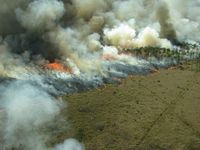As the fire hazardous season approaches in Russia, officials are taking proactive measures to mitigate the risk of wildfires across various regions. On March 28, 2025, Aleksey Kvetkov, the Deputy Head of the Main Directorate of the Ministry of Emergency Situations of the Russian Federation for the Novosibirsk Region, announced during a press conference at TASS that the start date of the fire hazardous season would vary across the region, depending on snow melt conditions in the forests.
Kvetkov noted that while some areas would see an earlier onset, others would experience a delayed start. This variability highlights the importance of local environmental conditions in determining fire risks. The initiation of the fire hazardous season requires the implementation of a special fire regime, which prohibits lighting fires and using open flames not only in forests but also on private properties, including dachas and household plots.
Last year, fines for violating these fire safety regulations were significantly increased, reflecting the urgency of the situation. Currently, individuals face fines ranging from 3,000 to 40,000 rubles, while officials may incur penalties of 40,000 to 60,000 rubles. Legal entities are subject to fines between 300,000 and 500,000 rubles. Kvetkov reported that since the beginning of 2025, there have already been 52 recorded violations of fire safety rules in the forests of the Novosibirsk region, with loggers being the primary offenders for burning logging residues.
The peak of the fire hazardous season in Siberia typically occurs from late April to early May, during which approximately 80% of all landscape and forest fires are reported. This alarming statistic emphasizes the critical need for effective prevention and response measures as conditions become increasingly favorable for wildfires.
In the Rostov region, similar preparations are underway. A draft resolution is currently being finalized, designating April 7, 2025, as the official start of the fire hazardous season. Notably, the Don forestry has already commenced its fire season earlier, on March 24. Sergey Bodyryakov, the Deputy Governor, highlighted that due to the anticipated rise in temperatures, a special fire regime will be implemented starting April 30, 2025. This regime will introduce additional fire safety requirements aimed at reducing the incidence of fires, injuries, and fatalities.
The new regulations will prohibit the burning of fires, garbage, dry vegetation, and household waste across the entire region. To further enhance preparedness, regional fire-tactical exercises will be conducted in various districts, with a significant exercise scheduled for April 17 in the Ust-Donetsk region. These drills aim to improve the skills and coordination of emergency response teams and test the effectiveness of fire response plans.
As part of the region's fire prevention strategy, over 2,500 controlled burns of dry vegetation have already taken place this year, covering an area of 928 hectares. Efforts are also being made to clear combustible waste from populated areas and to establish firebreaks along roads, settlements, and forested areas, with plans to complete these tasks before the fire hazardous season officially begins.
Currently, the total force mobilized in the Rostov region consists of 7,328 personnel, including regional fire and rescue units, municipal forces, and volunteer fire brigades. Additionally, 1,461 units of specialized equipment are prepared for deployment in firefighting efforts.
Since the start of 2025, the Rostov region has experienced 149 landscape fires, affecting more than three hectares of land. Encouragingly, this represents a 17% decrease in the number of fires compared to the same period last year, when 180 fires had occurred, impacting four hectares of land. This reduction may be attributed to the proactive measures implemented by local authorities.
As the fire hazardous season looms, both the Novosibirsk and Rostov regions are ramping up their efforts to prevent and respond to wildfires. With the combination of increased fines for violations, proactive fire management strategies, and community engagement through drills and training, officials are hopeful that they can mitigate the impact of wildfires this season.
The urgency of these measures is underscored by the forecast for 2025, which predicts the highest classes of fire danger from April to September. As temperatures rise and conditions become more conducive to wildfires, the importance of community awareness and adherence to fire safety regulations cannot be overstated. Local residents are encouraged to stay informed about fire safety practices and to report any suspicious activities that could lead to fire outbreaks.
In conclusion, the collaborative efforts between government officials, emergency services, and local communities are vital in ensuring a safer environment during the fire hazardous season. Only through vigilance and proactive measures can the devastating effects of wildfires be minimized, protecting both people and the natural landscape.





